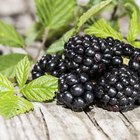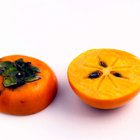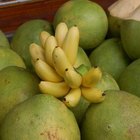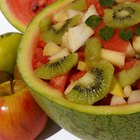
HandmadePictures/iStock/Getty Images
Many Americans start their mornings with a glass of orange juice. Orange juice is not only delicious, it's packed with vitamin C and potassium, and it's low in fat. But if you're trying to increase your consumption of dietary fiber, trade your morning glass of orange juice for a whole orange.
Orange Juice Fiber Content
Orange juice does not have dietary fiber, no matter how much pulp it contains. For instance, Simply Orange's High Pulp variety has 26 grams of carbohydrates but no fiber per 8-ounce serving. Florida Natural's Most Pulp variety also has 26 grams of carbohydrates but no fiber per serving. Both brands of juice have 110 calories per serving.
Fiber Content in Whole Oranges
Like orange juice, whole oranges are loaded with vitamin C, potassium and other nutrients. They also retain all of their dietary fiber in natural fruit form. According to the Centers for Disease Control and Prevention, one medium orange contains 3 grams of fiber for 11 percent of your recommended daily value of dietary fiber. In addition, the orange has only 70 calories.
Insoluble Fiber
What whole oranges contain and orange juice lacks is insoluble fiber, one of the two types of dietary fiber. According to the Vegetarian Times website, the exterior portions of fruits and vegetables contain the insoluble fiber, in the form of cellulose. So while the juicy part of the orange contains the vitamin C, the membrane around that juicy part is the source of the fiber. Juicing removes that membrane.
Benefits of Insoluble Fiber
Insoluble fiber, found in orange membranes as well as apple peels, celery strings and other parts of plant foods, helps keep the intestines working well. The fiber sweeps undigested food through the body, speeding intestinal transit time. It helps prevent constipation, hemorrhoids and other gastrointestinal problems. The American Heart Association reports that insoluble fiber reduces your risk of heart disease and can help you control your weight. It makes you feel full, which decreases your risk of overeating.
Recommendation
In general, you should eat whole fruits rather than drinking their fruit juices--even 100 percent fruit juices. Whole fruit contains more fiber and more of other specific nutrients. And whole fruits are often lower in calories.
Related Articles

How to Keep Pomegranate Fresh

Information About the Orange Fruit

Best Fruit Juices to Cleanse the Colon
How to Clean a Kiwi so the Skin Is Safe ...

Fiber in Blackberries

Where to Buy Pomegranate Juice

Juicing for Wrinkles
How to Wash Fresh Fruit With Peroxide

What Effects Do Oranges Have on the ...

Types of Greek Fruits & Vegetables

Kiwis vs. Oranges

How to Julienne Jicama

Is an Orange Healthy to Eat for Your ...

What Are the Benefits of Persimmons?

How to Juice Kiwi Fruit

Foods From Rainforest Plants

Fruits & Vegetables Rich in Potassium ...

What Are the Benefits of Grapefruit for ...

What Fruit Has the Most Fiber?

How Much Fiber Is in a Tangerine?
References
Writer Bio
Elisabeth Dahl is a freelance writer and copyeditor who has worked in publishing since 1991. She holds a Bachelor of Arts degree from Johns Hopkins University and a Master of Arts degree from Georgetown University, where she was a Writing Center Associate Fellow.
Photo Credits
HandmadePictures/iStock/Getty Images